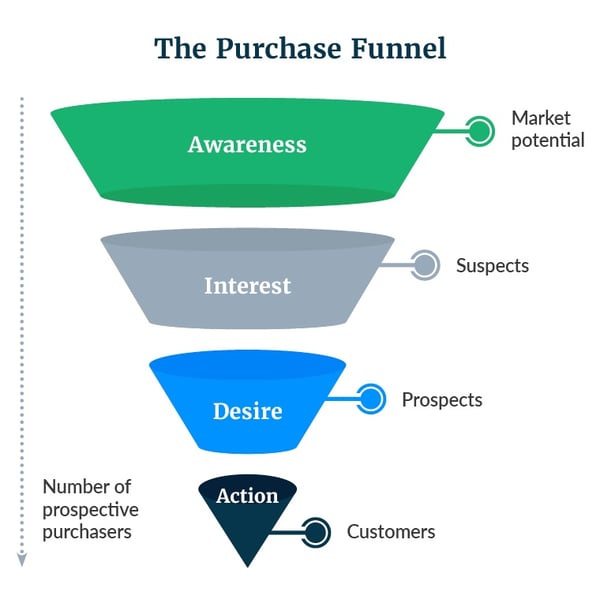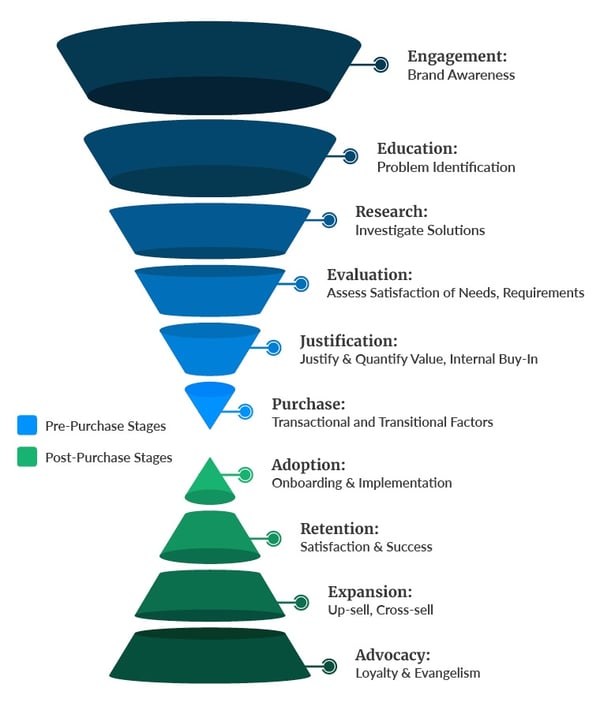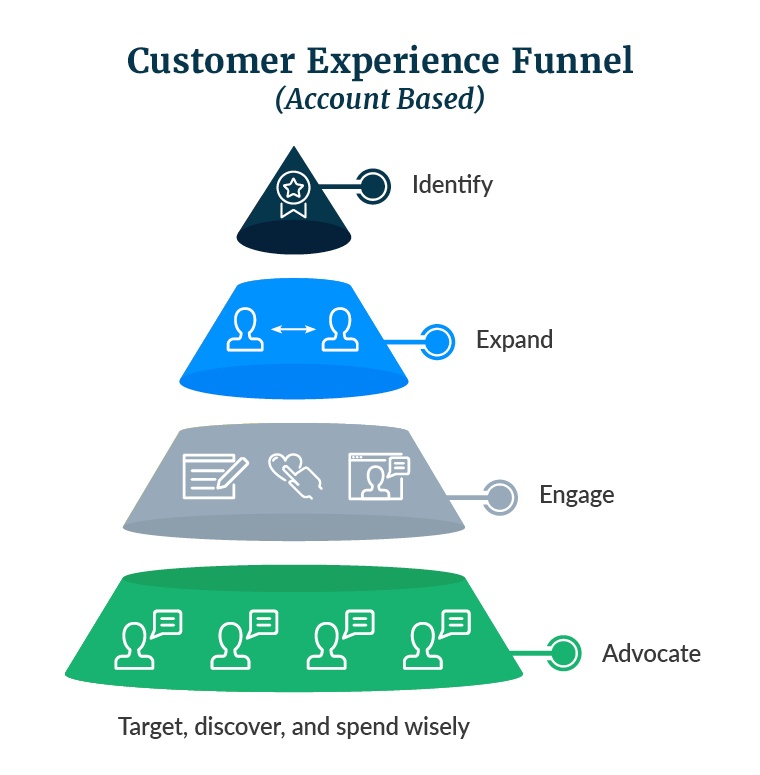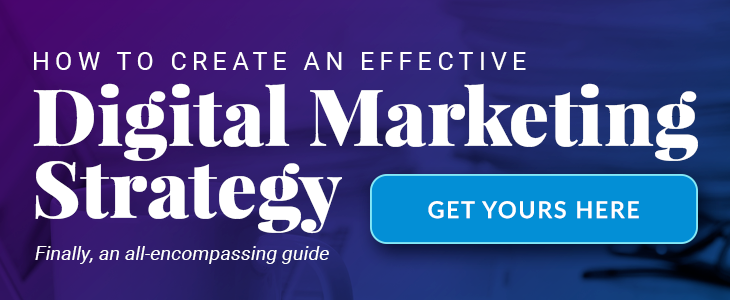
The Digital Marketing Funnel is Evolving. Are You Prepared?

This blog post is Part 1 in a three-part series on the digital marketing funnel, including what it is, how to use it strategically and how companies are successfully implementing it.
First, a Little History on the Funnel
Today modern marketers are familiar with the typical marketing funnel—awareness, nurture, convert and delight. But did you know that the idea of a sales funnel is not new—in fact, it’s 120 years old!
A Mr. E. St. Elmo created the first “purchase model” way back in 1898 in an effort to systematize the sales process and, ultimately, improve results. He developed a model that mapped a theoretical customer journey from the moment a product attracted a consumer’s attention to the point of action or purchase. His model has guided marketers and sales teams for nearly a century.
Old-school marketers are likely familiar with Mr. Elmo’s four-step purchase model, including its legendary acronym: AIDA, which stands for awareness, interest, desire and action:
- Awareness – the customer becomes aware of a product or service
- Interest – the customer actively expresses an interest in a product or service
- Desire – the customer aspires to acquire the product or service
- Action – the customer purchases the product or service
Clearly, the idea was genius and never died—it just took on new forms over the years as the marketing universe changed. The early model has been modified over the past decades by marketing consultants and academics to cater to the changing marketplace. Several variations on the theme have been created to accommodate the emerging modes of marketing—especially, digital marketing.

Today’s Modern Digital Marketing Funnel
When it comes to marketing and sales models, the internet changed everything. The advent of the internet has led to major shifts in marketing strategy—not entirely upending, but greatly modifying and expanding the original AIDA model. This has given rise to the digital marketing funnel, a method that focuses on brand engagement, education and embracing the non-linear way in which internet-based customers experienced the act of shopping.
The basics of the modern digital marketing funnel include four key stages (similar to AIDA): attract, nurture, convert and delight. However, to accommodate the many different kinds of marketing projects required to compete in today’s fierce online marketing battleground, the funnel steps have expanded. Numbers vary, but these 10 steps often comprise well-oiled digital marketing funnels. The first six stages take place before and up to the point of sale. The last four occur after the point of sale. Here’s a brief overview:
- Engagement (aka, brand awareness) - Today, brand awareness often begins online, typically on of one the many social media platforms, like Facebook, Twitter, YouTube and LinkedIn, where consumers discover brands. The goal is to reach a large number of people and start attracting potential customers from the masses. Engagement can take a variety of forms, including free offers for educational content, social media posts or ads or reviews from friends and family.
- Education (aka, problem identification) - The discovery stage that started with engagement continues with educating consumers about the brand. This includes clearly identifying consumers’ problems and providing insight to help solve them.
- Research (aka, investigate solutions) - The discovery stage continues with consumer research. Visitors are often focused on consuming content and learning more about the company and its products. They are looking to understand why they should choose a particular company. At this stage, the goal is not to overwhelm the consumer with offers, but provide the necessary information to be considered.
- Evaluation (aka, assess needs) - At this point, it’s time to present a specific solution to the problem. Customers may be looking at multiple competing solutions to their problem, so the focus should be on showing them why a particular product is their best solution, for example, through clear benefits and cost comparisons with competitors.
- Justification (aka, quantify value) - Often, marketers succeed at convincing prospects that their solution is the best one for them, but still don’t make a sale due to consumers’ objections, obstacles or inertia. The justification stage is about finding ways to overcome these issues. They need reasons why they should pull the trigger.
- Purchase (aka, transaction occurs) - At some point, some prospects will become customers. The purchase stage is all about the sale. Marketers should support the sales process by answering all of their questions and making them feel confident with the product’s value.
- Adoption (aka, onboarding and implementation) - Post-purchase is time to deliver on everything a company has promised its new customers. It’s important communications continue after the purchase via fulfillment, support and customer service, such as educational materials on how to get the most out of the products.
- Retention (aka, satisfaction and success) - Converting a prospect into a customer is a major achievement. But now marketers have to retain them as satisfied customers. One way that brands achieve this is through ongoing high-value communications.
- Expansion (aka, upsell and cross-sell) - Ideally, customers should not only be satisfied with their original purchases, but also become repeat consumers. Marketing campaigns should be built around upselling customers higher-end products and cross-selling them complimentary products. Expanding your relationship with consumers is easier if they view your brand as dependable and as an authority. Your ongoing communications should telegraph this message loudly and clearly.
- Advocacy (aka, loyalty and evangelism) - This is often one of the most overlooked stages in the marketing funnel. But brands who work to turn their satisfied customers into advocates often score major rewards for their efforts. Satisfied customers can spread the word to a whole new universe of prospects, including their peers, colleagues, family and friends.

Is “Flipping the Funnel” the Future of Digital Marketing?
As high-impact as the new digital marketing sales funnel is, some marketing industry experts are talking about a whole new approach to digital marketing. Instead of the funnel as we know it—wide on top and narrow on the bottom—they are advocating we “flip the funnel” to accommodate a new approach to marketing called Account-Based Marketing (ABM).
The ABM strategy begins with identifying and targeting best-fit accounts. Marketers then serve personalized messaging to all of the decision-makers at the accounts. The idea is based on the notion that individuals rarely make purchasing decisions on their own anymore. Instead, a team of often seven to 20 people are involved in the decision-making process. This means marketers have to reach all the decision makers within a particular company. To support this approach, marketers have identified five stages in the ABM model:
- Identify. Marketing and sales teams must collaborate on a list of target accounts or companies that are the best fit for the solution. To do this, it’s crucial they agree on their ideal customer profile and individual buyer personas.
- Expand. Next, take the list of target accounts and expand the company profiles with the contact information of key stakeholders and decision makers.
- Engage. Now, execute an omni-channel marketing plan and begin to engage contacts in the target accounts by employing a variety of sales and marketing tactics—including content marketing, personalized emails, events and phone calls.
- Advocate. After your sales team successfully closes a deal, the marketing team needs to work to transform satisfied customers into brand advocates.
- Measure. Measure the success of the ABM campaigns by focusing on account-level KPIs that reflect the marketing team’s contribution to pipeline and revenue (ROI).

Part 2 in this three-part blog post series will look at how to set up a powerful digital marketing campaign strategy.





